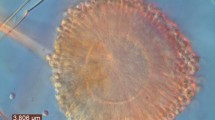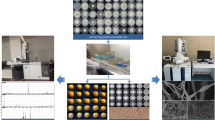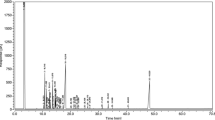Abstract
Essential oils are aromatic oily liquids obtained from some aromatic plant materials. Certain essential oils such as citronella oil contain antifungal activity, but the antifungal effect is still unknown. In this study, we explored the antifungal effect of citronella oil with Aspergillus niger ATCC 16404. The antifungal activity of citronella oil on conidia of A. niger was determined by poisoned food technique, broth dilution method, and disc volatility method. Experimental results indicated that the citronella oil has strong antifungal activity: 0.125 (v/v) and 0.25 % (v/v) citronella oil inhibited the growth of 5 × 105 spore/ml conidia separately for 7 and 28 days while 0.5 % (v/v) citronella oil could completely kill the conidia of 5 × 105 spore/ml. Moreover, the fungicidal kinetic curves revealed that more than 90 % conidia (initial concentration is 5 × 105 spore/ml) were killed in all the treatments with 0.125 to 2 % citronella oil after 24 h. Furthermore, with increase of citronella oil concentration and treatment time, the antifungal activity was increased correspondingly. The 0.5 % (v/v) concentration of citronella oil was a threshold to kill the conidia thoroughly. The surviving conidia treated with 0.5 to 2 % citronella oil decreased by an order of magnitude every day, and no fungus survived after 10 days. With light microscope, scanning electron microscope, and transmission electron microscope, we found that citronella oil could lead to irreversible alteration of the hyphae and conidia. Based on our observation, we hypothesized that the citronella oil destroyed the cell wall of the A. niger hyphae, passed through the cell membrane, penetrated into the cytoplasm, and acted on the main organelles. Subsequently, the hyphae was collapsed and squashed due to large cytoplasm loss, and the organelles were severely destroyed. Similarly, citronella oil could lead to the rupture of hard cell wall and then act on the sporoplasm to kill the conidia. Nevertheless, the citronella oil provides a potential of being a safe and environmentally friendly fungicide in the future.





Similar content being viewed by others
References
Al-Ja’fari AH, Vila R, Freixa B, Tomi F, Casanova J, Costa J, Canigueral S (2011) Composition and antifungal activity of the essential oil from the rhizome and roots of Ferula hermonis. Phytochem 72:1406–1413
Arora DS, Kaur J (1999) Antimicrobial activity of spices. Int J Antimicrob Ag 12:257–262
Bajpai VK, Yoon JI, Kang SC (2009) Antifungal potential of essential oil and various organic extracts of Nandina domestica Thunb. against skin infectious fungal pathogens. Appl Microbiol Biotechnol 83:1127–1133
Bakkali F, Averbeck S, Averbeck D, Idaomar M (2008) Biological effects of essential oils—a review. Food and Chem Toxicol 46:446–475
Beneti SC, Rosset E, Corazza ML, Frizzo CD, Luccio MD, Oliveira JV (2011) Fractionation of citronella (Cymbopogon winterianus) essential oil and concentrated orange oil phase by batch vacuum distillation. J Food Eng 102:348–354
Billerbeck VG, Roques CG, Bessière J-M, Fonvieille J-L, Dargent R (2001) Effects of Cymbopogon nardus (L.) W. Watson essential oil on the growth and morphogenesis of Aspergillus niger. Can J Microbiol 47:9–17
Burt S (2004) Essential oils: their antibacterial properties and potential applications in foods—a review. Int J Food Microbiol 94:223–253
Ceylan E, Fung DYC (2004) Antimicrobial activity of spices. J Rapid Meth Aut Mic 12:1–55
Charles S, Chester E, Henry T (1947) Molds, yeasts, and actinomycetes. Soil Sci 63(5):418
Chuang PH, Lee CW, Chou JY, Murugan M, Shieh BJ, Chen HM (2007) Anti-fungal activity of crude extracts and essential oil of Moringa oleifera Lam. Bioresource Technol 98:232–236
Delespaul Q, Billerbeck VG, Roques CG, Michel G (2000) The antifungal activity of essential oils as determined by different screening methods. J Essent Oil Res 12:256–266
European Commission (2009). 2009/251/EC: Commission decision of 17 March 2009 requiring member states to ensure that products containing the biocide dimethylfumarate are not placed or made available on the market. Official Journal of the European Union
European Commission (2012). 2012/48/EU: Commission implementing decision of 26 January 2012 extending the validity of decision 2009/251/EC requiring member states to ensure that products containing the biocide dimethylfumarate are not placed of made available on the market. Official Journal of the European Union
Hiramatsu Y, Shida S, Miyazaki Y (2008) House dust mites and their sensitivity to wood oils and volatiles. J Wood Sci 54:1–9
Inouye S, Takizawa T, Yamaguchi H (2001) Antibacterial activity of essential oils and their major constituents against respiratory tract pathogens by gaseous contact. J Antimicrob Chemoth 47:565–573
Li WR, Xie XB, Shi QS, Zeng HY, Ouyang YS, Chen YB (2010) Antibacterial activity and mechanism of silver nanoparticles on Escherichia coli. Appl Microbiol Biotechnol 85:1115–1122
Li WR, Xie XB, Shi QS, Duan SS, Ouyang YS, Chen YB (2011) Antibacterial effect of silver nanoparticles on Staphylococcus aureus. Biometals 24:135–141
Man HC, Hamzah MH, Jamaludin H, Abidin ZZ (2012) Preliminary study: kinetics of oil extraction from citronella grass by ohmic heated hydro distillation. APCBEE Procedia 3:124–128
Nogueira JHC, Gonçalez E, Galleti SR, Facanali R, Marques MOM, Felício JD (2010) Ageratum conyzoides essential oil as aflatoxin suppressor of Aspergillus flavus. Int J Food Microbiol 137:55–60
Rammanee K, Hongpattarakere T (2011) Effects of tropical Citrus essential oils on growth, aflatoxin production, and ultrastructure alterations of Aspergillus flavus and Aspergillus parasiticus. Food Bioprocess Tech 4:1050–1059
Rasooli I, Rezaei MB, Allameh A (2006) Growth inhibition and morphological alterations of Aspergillus niger by essential oils from Thymus eriocalyx and Thymus x-porlock. Food Control 17:359–364
Rassoli I, Owlia P (2005) Chemoprevention by thyme oils of Aspergillus parasiticus growth and aflatoxin production. Phytochemistry 66:2851–2856
Razzaghi-Abyaneh M, Shams-Ghhfarokhi M, Kawachi M, Eslamifar A, Schmidt OJ, Schmidt A, Allameh A, Yoshinari T (2006) Ultrastructural evidences of growth inhibitory effects of a novel biocide, Akacid®plus, on an aflatoxigenic Aspergillus parasiticus. Toxicon 48:1075–1082
Sharma N, Tripathi A (2006) Fungitoxicity of the essential oil of Citrus sinensis on post-harvest pathogens. World J Microb Biot 22:587–593
Sharma N, Tripathi A (2008) Effects of Citrus sinensis (L.) Osbeck epicarp essential oil on growth and morphogenesis of Aspergillus niger (L.) Van Tieghem. Microbiol Res 163:337–344
Shelef LA (1983) Antimicrobial effects of spices. J Food Safety 6:29–44
Sindhu S, Chemakam B, Leela NK, Bhai RS (2011) Chemoprevention by essential oil of turmeric leaves (Curcuma longa L.) on the growth of Aspergillus flavus and aflatoxin production. Food Chem Toxicol 49:1188–1192
Solomon B, Sahle FF, Gebre-Mariam T, Asres K, Neubert RHH (2012) Microencapsulation of citronella oil for mosquito-repellent application: formulation and in vitro permeation studies. Eur J Pharm Biopharm 80:61–66
Tian J, Ban X, Zeng H, He J, Huang B, Wang Y (2011) Chemical composition and antifungal activity of essential oil from Cicuta virosa L. var. latisecta Celak. Int J Food Microbiol 145:464–470
Tolouee M, Alinezhad S, Saberi R, Eslamifar A, Zad SJ, Jaimand K, Taeb J, Rezaee MB, Kawachi M, Shams-Ghahfarokhi M, Razzaghi-Abyaneh M (2010) Effect of Matricaria chamomilla L. flower essential oil on the growth and ultrastructure of Aspergillus niger van Tieghem. Int J Food Microbiol 139:127–133
Yahyazadeh M, Omidbaigi R, Zare R, Taheri H (2008) Effect of some essential oils on mycelial growth of Penicillium digitatum Sacc. World J Microbiol Biotechnol 24:1445–1450
Zhou DQ (2003). Filamentous fungi—mold. Textbook of microbiology. Higher Education Press (pressed in Chinese), Beijing. pp. 53–54
Acknowledgments
The author gratefully acknowledges the support by Guangdong Provincial Science and Technology Project (2009B011000011, 2011B010400039), the National Natural Science Fund of China (U1133003, 41176104, 20971028), and Guangdong Natural Science Fund (10151007002000000).
Author information
Authors and Affiliations
Corresponding authors
Electronic supplementary materials
Below is the link to the electronic supplementary material.
ESM 1
(DOCX 16178 kb)
Rights and permissions
About this article
Cite this article
Li, WR., Shi, QS., Ouyang, YS. et al. Antifungal effects of citronella oil against Aspergillus niger ATCC 16404. Appl Microbiol Biotechnol 97, 7483–7492 (2013). https://doi.org/10.1007/s00253-012-4460-y
Received:
Revised:
Accepted:
Published:
Issue Date:
DOI: https://doi.org/10.1007/s00253-012-4460-y




